

![]()

 I. Identification
I. IdentificationThat tradition matters in the global age has become obvious in the case of grappa, an alcoholic drink that has not only become popular lately, but that has also become the bone of contention between the European Union and South Africa. The contention has resulted in a vast dispute that has gone on for some four years now. The disputed issue is protection of traditional denominations in the area of wines and spirits (such as grappa or ouzo) following the application of certain chapters of the Trade, Development and Cooperation Agreement (TDCA) between the European Union and South Africa. On the European Union side, Italy is the major advocate for strict protectionism, requiring South Africa to phase out the use of the term "grappa" by South African distillers within five years. The dispute has delayed a crucial $17-billion free trade agreement between South Africa and Europe that was to give way to significant tariff cuts on South Africa's import and export trade with Europe. The dispute has not been delegated to the World Trade Organization for resolution, but instead has been negotiated on a bilateral level between the European Union and South Africa. Nevertheless, as protectionist policies of the EU especially in the area of agricultural products have grown in number and in intensity, it has become apparent that intellectual property issues are gaining importance and can no longer be left unnoticed. Perhaps also as a result of protectionist concerns voiced by the EU, general guidelines on protection of intellectual property rights have been developed just recently through the WTO mechanism. The WTO Agreement on Trade-Related Aspects of Intellectual Property Rights (TRIPS; 1995) has gained momentum as a set of underlying principles in international trade to be observed by all WTO members. While the TRIPS Agreement is a fairly new theoretical development, the EU-South Africa dispute is a clear example of application of the TRIPS principles in the area of agricultural or food products.
What Is Grappa?
Grappa is an alcoholic drink identified commonly as pomace brandy, spirit or distillate. Journalist Daniel Wakin defines grappa simply as "distillation of the sediment left after pressing grapes to make wine."1 The National Grappa Institute in Brescia, Italy, denominates grappa as
the spirit produced from grape marc (i.e. from the skins of the grapes after they have been separated from the must or the wine) possibly with a percentage of wine lees. Raw materials must be obtained from grapes produced and processed in Italy, distilled in plants located in Italy and complying with well-defined requirements, as set forth by the regulations in force.2
EU Regulation 1576/89 describes grape marc spirit, grape marc or grappa (all three terms are virtually interchangeable) as
a spirit drink
- produced from grape marc fermented and distilled either directly by water vapour, or after water has been added; a percentage of lees that is to be determined in accordance with the procedure laid down in Article 15 may be added to the marc, the distillation being carried out in the presence of the marc itself at less than 86 % vol. Redistillation at the same alcoholic strength is authorized,
- containing a quantity of volatile substances equal to or exceeding 140 grams per hectolitre of 100 % vol alcohol and having a maximum methyl alcohol content of 1000 grams per hectolitre of 100 % vol alcohol. 3
Having originally emerged as a poor man's drink, grappa has recently attained status equivalent to that of Scotch whisky or exquisite cognacs. Italians sip it for breakfast, its is added into coffee and also used as a digestive after meals or an ingredient in cooking (e.g., in cakes, cookies and homemade sausages).
What Is the History and Present of Grappa Production?
Italians claim that grappa was invented in their country. Although it is impossible to quote the year of invention, most sources claim several centuries worth of tradition for this product. Grappa's origins are unclear and several theories have been proposed by historians explaining how the drink first emerged. While certain historians go as far back in history as the 5th century, attributing distillation skills to the Burgundians, others attribute this knowledge to Friulians (inhabitants of a northern Italy region) even before the 5th century. Yet another theory refers to the 9th century Sicily occupied by the Arabs who had brought distilling to Europe. A general consensus dates grappa at least 1500 years old. Resourceful peasants in North Italy developed grappa not only to use up the pomace leftovers from wine production, but also to find escape from their hard work and cold winter temperatures. The 1960s and 1970s witnessed a rediscovery of grappa thanks to a growing popularity of elegant Italian cuisine.4
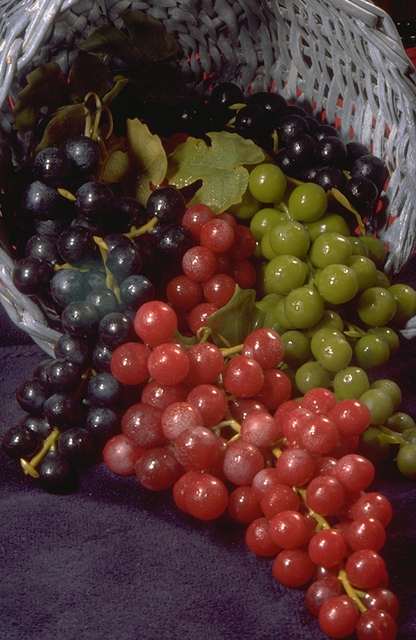 Generally
speaking, grappa is a marc-based spirit. The marc liquor is distilled
from grape skins (pomace) left over in the wine press after grape pressing for
juice during regular wine-production. Italian producers have elaborated their
production techniques, priding themselves on high-quality grappa made from marc
exclusively after the first pressing. Such marc still contains much of the original
flavor of the particular grape type and thus the final product resembles brandy
or fruit-based liquor. The higher content of moisture in this pomace also improves
the quality of destilled grappa.
Generally
speaking, grappa is a marc-based spirit. The marc liquor is distilled
from grape skins (pomace) left over in the wine press after grape pressing for
juice during regular wine-production. Italian producers have elaborated their
production techniques, priding themselves on high-quality grappa made from marc
exclusively after the first pressing. Such marc still contains much of the original
flavor of the particular grape type and thus the final product resembles brandy
or fruit-based liquor. The higher content of moisture in this pomace also improves
the quality of destilled grappa.
The recent trend has been for each Italian distillery to produce its own variant of grappa and that thousands of different grappa varieties are estimated to exist.5 Nowadays, grappa producers see their priority in quality, not quantity. Grappa is no longer just a brandy of the common man. Modernized production technologies and the competitiveness of the field have driven the trend towards marketing grappa in creative packaging and exquisitely blown bottles of miscellaneous shapes whereby the aesthetic features of the product underline its reputable quality.
How Is Grappa Produced?
Grappa distilling is a rather complex and expensive process. Generally speaking, Italian producers concentrate on producing smaller quantities, but of superior quality.
The main substance used in grappa production is pomaces, i.e. skins of grapes pressed during wine production. Pomaces delivered to the distillery can be of three varieties, depending on the degree of their fermentation: pure (from white wines); half-fermented (from rosato); and fully fermented (from red wine). During the production, fruit sugar is transformed into high-percentage alcohol in two major steps: (1) pressing & fermentation and (2) distillation.
The purpose of distillation is simply to separate alcohol from water. Pomaces must be distilled solid, because Italian law prohibits adding water.6 For a more technical clarification of the process, let's refer to an explanation provided in the Behrendts' book:
The pomace is heated until it gives off steam, which is then captured, cooled, and condensed into a liquid. The highly volatile substances such as methyl alcohol, ethyl esters of acetic acid, and acetaldehyde have the lowest boiling point, and since they not only ruin the taste of the distillate but are in some cases poisonous, they are cut off from the run as the so-called head. The purest alcohol and aromatic substances appear as steam at medium temperatures. Only this middle part of the run, the "heart" of the distillation, is condensed into grappa. In the "tail," which is also cut off, are water and still more impurities, chiefly fusel oils such as amyl alcohol. The distiller has to be able to distinguish between the several phases and be certain of capturing only the middle run. The more successfully it is separated from the head & tail, the purer and more delicate the distillate.7
Although grappa does not generally require such a long aging as some other alcoholic drinks do, Italian law requires six months of aging after the production itself is complete. However, there are distilleries that not only age grappa for six months in wooden barrels, but also add another six months of aging in airtight glass flasks or stainless-steel tanks. This added step in the production process allows producers subsequently to add more prestigious label designations such as invecchiata (i.e., aged), stravecchia (very old) or riserva (reserve). 8 Other varieties of grappa include flavored grappas produced by adding natural herbal extracts or fruits that create such surprising flavors as cinnamon, hazelnut, almond or strawberry. Distilleria Marzadro is probably the best example of Italian inventiveness when it comes to flavored grappas: imagine such flavors as Blueberry-Peach, Banana-Fig or Raspberry-Liquorice.
Among the well-known Italian grappa producers are Nardini, Brunello, Mangilli and Stock.
Which Countries Are Involved in the Trade Dispute And What Are Their Positions?
 EUROPEAN
UNION has a common trade and agriculture policy that requires all
EU member countries to agree among themselves on a shared approach which is
then put forth in negotiations with their non-EU trading partners. All 15
EU member countries act as one in external negotiations. Since Italy had disagreed
with South Africa's use of the term "grappa," the EU as a whole has required
the negotiation of a separate EU-SA agreement on trade in wines and spirits
and the protection of spirits denominations before the EU - South Africa Trade,
Development and Cooperation Agreement can come into effect. In order for the
TDCA to come into effect, all EU member countries must complete the ratification
process. EU's philosophy in this dispute is that the protection of intellectual
property rights functions as a driving force for future growth of industries.
EUROPEAN
UNION has a common trade and agriculture policy that requires all
EU member countries to agree among themselves on a shared approach which is
then put forth in negotiations with their non-EU trading partners. All 15
EU member countries act as one in external negotiations. Since Italy had disagreed
with South Africa's use of the term "grappa," the EU as a whole has required
the negotiation of a separate EU-SA agreement on trade in wines and spirits
and the protection of spirits denominations before the EU - South Africa Trade,
Development and Cooperation Agreement can come into effect. In order for the
TDCA to come into effect, all EU member countries must complete the ratification
process. EU's philosophy in this dispute is that the protection of intellectual
property rights functions as a driving force for future growth of industries. ITALY
ITALY
 SOUTH
AFRICA
SOUTH
AFRICA What Is the History of the Dispute?
|
May 29, 1989
|
EU grants Italy the exclusive rights to the "grappa" denomination through Council Regulation 1576/89. |
|
January 1, 1995
|
WTO TRIPS Agreement is signed. It also provides protection to "Food Geographic Indications" or specific food products that are associated with particular geographic locations. This agreement applies to all WTO members, including Italy and South Africa and has evolved into a major factor in agricultural trade disputes. |
|
June 1995
|
Formal negotiations of the Agreement between EU and South Africa open |
|
March 24, 1999
|
EU concludes the TDCA with South Africa |
|
October 11, 1999
|
EU and South Africa sign a comprehensive free trade agreement that was to become effective on January 1, 2000. The agreement took four years of negotiations during the SA presidency of Nelson Mandela. Italy refused to ratify this agreement until a parallel agreement on wines and spirits had not been reached. |
|
February 2000
|
South Africa accepts a compromise, binding it to phase out the use of spirits names such as "grappa" and "ouzo" within five years. |
|
June 9, 2000
|
EU and South Africa reach a provisional technical agreement on the conclusion of two bilateral wine and spirit trade agreements. |
What Is the TDCA?
The TDCA stands for the Trade, Development and Cooperation Agreement between the European Union and South Africa. The EU - South Africa negotiations of the TDCA (spurred by South Africa's desire for an improved access to the EU market) were concluded on March 24, 1999 and the TDCA was signed on October 11, 1999. The Agreement is binding not only for the EU as a whole, but also for its individual member countries. This agreement will be fully implemented only upon the ratification by all 15 EU member states, which is a farily lengthy process. Therefore, it is imperative that all countries ratify the Agreement, which is a process likely to take a long time. The negotiations were rather thorough and lengthy as the TDCA had to be fully compatible with WTO rules to ensure its legitimacy. The Agreement contains a chapter on development that justifies EU's continued financial and technical assistance to South Africa.9
What Are the Implications of the Dispute for South Africa and Its Trade?
This trade dispute threatens to disable the 2000 quota on 32 million liters of tariff-free imports of South African liquor to the European Union market, which is a direct impact. Indirectly, the dispute has caused a considerable delay in the coming into effect of the Trade, Development and Cooperation Agreement (TDCA) that is of crucial importance to South Africa. The TDCA is South Africa's gateway to long-term development cooperation and financial assistance from the EU supporting development activities. The grappa dispute has prevented South Africa from full enjoyment of the benefits of this treaty and from receiving financial aid from the EU. When an agreement is finally reached on the mutual protection of wine and spirit denominations and of certain traditional names of spirits including grappa, EU's financial assistance to South Africa worth €15 million will finally take effect.
Below is a list of TED cases that have lead to trade disputes based on the application and alleged infringement of intellectual property rights. Several of the cases also specifically deal with alcohol. All of these cases are part of the Trade and Environment Database. The majority of intellectual property rights cases contained in this database fall in the area of food and agricultural products. In this age of open global trade, a growing number of national producers seek protection of their historically unique or traditional products. They try to claim exclusive rights to food products that have distinctive characteristics derived from far-reaching reputation, traditional recipes and technologies as well as from its ties to a particular geographical location.
![]()
The trade dispute between the EU and South Africa over the use of denomination "grappa" falls under intellectual property rights. Intellectual property rights are particularly significant in cases where new scientific and technological inventions are concerned, e.g. in the case of medicine research. Protection guaranteed by intellectual property rights serves as a motivation for inventors to carry out advanced research as they can be asured that there will be future financial benefits from the sale of their new patented product. As regards to spirits or food in general, research probably does not get nearly as technical or as expensive as it may be in scientific fields. Yet, alcohol, too, is an example of intellectual property considering that Italian producers of grappa exert much energy to increase their competitiveness by inventing more advanced manufacturing methods, by refining the taste of their products as well as by designing attractive bottles and labels for selling grappa. Romano Levi is probably the most lucid example of a grappa distiller who not only makes a world-class spirit, but who also manually paints his own bottle labels. It is only understandable that Italian manufacturers wish to prevent other non-Italian producers from cashing on their hard work and invention. Italy, the traditional producer of grappa, claims its full right to the use of such denomination of this particular alcoholic drink.
Relevant to this case are regulations adopted by three different entities, namely WTO, EU and Italy.
WTO
Intellectual property rights are regulated by the World Trade Organization to which both the EU and South Africa are parties. The particular agreement most relevant to this case is TRIPS: Agreement on Trade-Related Aspects of Intellectual Property Rights. Formally, the TRIPS Agreement is Annex 1C of the Marrakesh Agreement, which was signed in Marrakesh, Morocco, on April 15, 1994 and established the WTO. (Consult the full text or an overview of the agreement.) The TRIPS Agreement was preceded by two major international agreements administered by the World Intellectual Property Organization: the Paris Convention for the Protection of Industrial Property (Stockholm, 1979) and the Berne Convention (Geneva, 1992) for the Protection of Literary and Artistic Works. Having come into effect on January 1, 1995, the TRIPS Agreement continues to be the most comprehensive multilateral agreement on matters concerning intellectual property, consolidating the multiple earlier WIPO conventions into one overall system. The TRIPS Agreement is the first international agreement that requires that all WTO members follow a comprehensive set of laws for protection of intellectual property rights. The TRIPS Agreement applies to areas such as copyright, trademarks, industrial designs, patents, trade secrets and geographical indications. Applicable to this case is Section 3 of the TRIPS Agreement entitled "Geographical Indications" that are defined by WTO as
indications which identify a good as originating in the territory of a Member, or a region or locality in that territory, where a given quality, reputation or other characteristic of the good is essentially attributable to its geographical origin. 10
Article 23 entitled "Additional Protection for Geographical Indications for Wines and Spirits" relates specifically to alcoholic beverages. Although this article does not list any specific beverages that would fall under the TRIPS protection, it can nevertheless be applied to the grappa case. It is unknown where in Italy the first grappa was made. Linguistically, the name is not tied to a specific location, but rather to the whole country of Italy. South Africa has raised a claim that grappa is a generic term for describing a product (such as for example coffee or tea would be) and therefore it should not be reserved for exclusive use by one country. A more lucent instance of a geographical indication would be "Scotch," a beverage that is tied explicitly in name and in production to Scotland. Regardless, it can be claimed that the name grappa does carry in itself a geographical (i.e. Italian) reference in the form of certain characteristics and reputation traditionally associated with the product and expected by prospective consumers worldwide. Although the WTO has not specifically ruled in the EU-South Africa dispute, the TRIPS Agreement provides a set of appropriate general guidelines.11
European Union
 The
European Union has passed "Council
Regulation (EEC) No 1576/89 of 29 May 1989 laying down general rules on
the definition, description and presentation of spirit drinks." This regulation
is based on the assertion that spirits are one of the major EU agricultural
export items and as such the EU must maintain their high quality standard and
reputation by setting proper definitions and preventing lower-quality products
from causing devaluation of these traditional beverages. Paragraph f of this
regulation specifically defines grape marc spirit or grape marc
(both technically the same as grappa) as
The
European Union has passed "Council
Regulation (EEC) No 1576/89 of 29 May 1989 laying down general rules on
the definition, description and presentation of spirit drinks." This regulation
is based on the assertion that spirits are one of the major EU agricultural
export items and as such the EU must maintain their high quality standard and
reputation by setting proper definitions and preventing lower-quality products
from causing devaluation of these traditional beverages. Paragraph f of this
regulation specifically defines grape marc spirit or grape marc
(both technically the same as grappa) as
a spirit drink- produced from grape marc fermented and distilled either directly by water vapour, or after water has been added; a percentage of lees that is to be determined in accordance with the procedure laid down in Article 15 may be added to the marc, the distillation being carried out in the presence of the marc itself at less than 86 % vol.
- containing a quantity of volatile substances equal to or exceeding 140 grams per hectolitre of 100 % vol alcohol and having a maximum methyl alcohol content of 1 000 grams per hectolitre of 100 % vol alcohol. 12
Point 2 of this Paragraph effectively grants Italy exclusive rights to the name "grappa" as it recognizes the inherent characteristics of the beverage and reserves the use of the term purely as denomination of the Italian alcoholic drink: "The name 'grape marc' or 'grape marc spirit' may be replaced by the designation grappa solely for the spirit drink produced in Italy." This regulation along with several subsequent rulings effectively prohibit the sale on EU markets of any grappa drinks produced outside of Italy.
Italy
Finally, Italy has adopted Decree 297/97 that lays down criteria for grappa manufacturing and designation. This decree stipulates that grappa must be produced from grapes grown in Italy and in distilleries located on Italian territory. That Italians are serious about the national tradition, quality and supremacy of their grappa can be proved by the foundation in 1996 of the Istituto Nazionale Grappa that represents approximately 70% of grappa produced in Italy and more than 100 companies producing the drink. The purpose of this institute is to set quality standards, promote information, conduct research and facilitate the trade of grappa.13
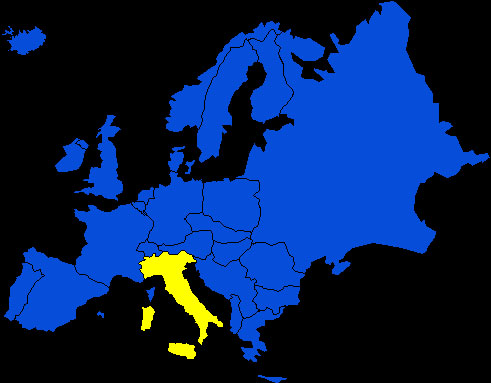 |
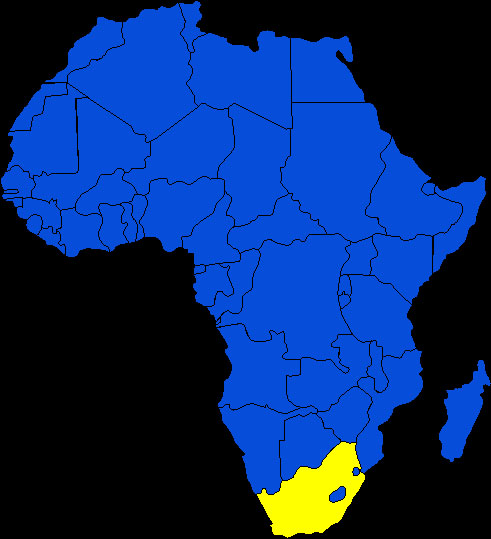 |
Click on the country for further general information.
a. Geographic Domain: Europe
b. Geographic Site: Southern Europe
c. Geographic Impact: South Africa
a. Directly Related to Product: Yes: Grappa
b. Indirectly Related to Product: Yes: Champaigne, Ouzo, Sherry, Korn, Pacharan, Jagatee
c. Not Related to Product: No
d. Related to Process: Yes: Intellectual Property
Brandy-like distillated alcoholic drink made from skins of grapes after they have been pressed.
There is virtually no official and reliable statistical data available on the volume of grappa production and trade worldwide. The few statistical data that I was able to locate typically contain aggregate date on all alcohol imports and exports, without specifying data for individual types of spirits.
However, several news reports that I have read on the subject stated that Italy produces some 40 million bottles of grappa per year, compared to a mere 30,000 bottles produced by South Africa.14
While Italy retains its claim on the sole ownership of the grappa name, the sale of grappa from South Africa or any country other than Italy is prohibited in the EU markets, based on the Wine and Spirit Agreement. South African grappa producers have been undeniably harmed by the prohibitive regulation that prevents them from marketing spirits under the name grappa.
However, in the long run, South Africa is likely to benefit to a large extent from the TDCA, primarily in the upcoming free trade. Under the TDCA provisionally put into effect, by the end of a 10-year transition period, 95% of EU imports from South Africa will be fully liberalised while 86% of EU imports into South Africa will be liberalised by the end of a 12-year transition period. The TDCA has been designed to assist South Africa in its ongoing effort to become economically integrated in the region following the end of apartheid. The TDCA also functions as a legal basis for financial aid from the EU dedicated in support of long-term development activities in the South Africa's social and economic spheres.
Export: Italy
Import: other EU countries, USA, Japan, Australia, China
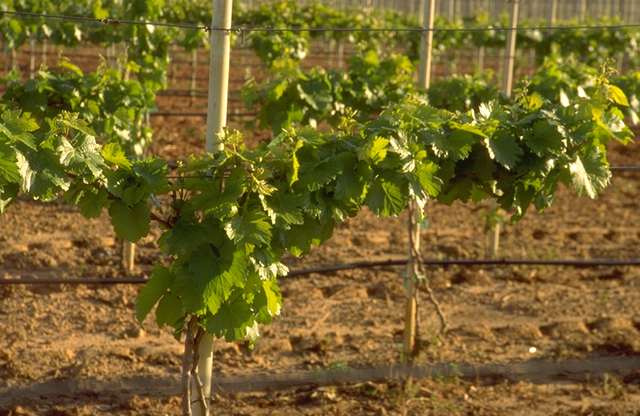 Due
to its moderate climatic conditions, Italy has a long-standing tradition of
wine production. The geographic conditions are favorable to grape-growing throughout
the country, but the regions or Piedmont and Tuscany are particularly known
for wine-making. The Italians claim that grappa originated in their country
and that it has become a unique part of Italian tradition in wine making. Wine
has been produced in Italy for centuries and grappa was "invented" as a by-product
of the wine making process. Originally a poor man's drink, grappa has recently
acquired the status of a high-quality and expensive brandy that has been sought
after by tourists in Italy and by sophisticated connoisseurs abroad alike. In
the U.S.A., only exclusive restaurants and specialized liquor stores (e.g. The
Wine Specialist) carry the Italian drink, which has become something of
a luxury item comparable in its status to cognac or Scotch whisky.
Due
to its moderate climatic conditions, Italy has a long-standing tradition of
wine production. The geographic conditions are favorable to grape-growing throughout
the country, but the regions or Piedmont and Tuscany are particularly known
for wine-making. The Italians claim that grappa originated in their country
and that it has become a unique part of Italian tradition in wine making. Wine
has been produced in Italy for centuries and grappa was "invented" as a by-product
of the wine making process. Originally a poor man's drink, grappa has recently
acquired the status of a high-quality and expensive brandy that has been sought
after by tourists in Italy and by sophisticated connoisseurs abroad alike. In
the U.S.A., only exclusive restaurants and specialized liquor stores (e.g. The
Wine Specialist) carry the Italian drink, which has become something of
a luxury item comparable in its status to cognac or Scotch whisky.
Environmental impact is potentially two-fold. First, a general impact of grape-growing such as possible fertilizer pollution may occur. Secondly, grappa production itself may bring about negative impact on the environment, although no significant environmental impact of grappa production per se has been described. However, the environment does have influence on the quality of grappa. According to the Behrendts' book, major factors that come into play here are the quality of soil, vine variety in pomace, the weather as well the microclimate of each individual vineyard. Among the vine varieties best suitable for grappa production are Riesling, Müller-Thurgau and Muscat. The climate is an important factor influencing indirectly the quality of grappa. Warm regions of southern Italy with much sunlight lower the content of acid in grapes used in grappa production. Grappas of high quality are produced from grapes with a higher ratio of acid content. Thus, northern cooler Italian regions are generally better suited for grappa production. Historically, the best known grappas come from distilleries located primarily in northern Italy, at the foothills of the Italian Alps. The primary locations of Italian grappa production are the regions of Friuli, Veneto, Alto Adige, Trentino and Piedmont. Nevertheless, even southern regions of Tuscany, Umbria or Sicily are known for high-quality grappa, proving that the microclimate of the vineyard truly matters.15
Name and Diversity: Many different varieties of grape are used in grappa production.
Among these are Moscato, Muller Thurgau, Traminer and Sauvignon.
Type: Plant
Italian producers have achieved a superior quality of the drink thanks to the quality standards set by the National Grappa Institute (Istituto Nazionale Grappa) that was founded in 1996. In Italy, over a hundred small, privately owned distilleries produce grappa and each of them takes pride in long-reaching history of their production. They have perfected the drink through specialization and years of experience in the industry and it is probably this history, along with quality, that makes the drink so popular on the international market. The history of each distillery is filled with intriguing details about the founders, subsequent owners and particularly with proud assertions of techniques and recipes handed down from one generation to another to the present day. Historically, northern Italy is the cradle of grappa making, but the region of Tuscany has subsequently taken to producing grappa in large quantities as well.
One of the many fascinating stories is that of distillery Ditta Bortolo Nardini that is located in Bassano Del Grappa, not far from Venice. Founded by Bortolo Nardini in 1779, the distillery is still owned by the same family, still housed in the same location and still uses the same techniques for the production of grappa. Its location on the bank of the Brenta River was strategically selected for the plentiful supply of water that is utilized during the distillation process as well as for the proximity of Venice, a ready market for the products. Despite the tradition, the distillery has expanded and incorporated modern technologies for manufacturing. Nardini's best-known product, Aquavite Nardini, is nicknamed the "mother of all grappas." It is a young white steam-distilled grappa and it does not sell cheap. Wine Specialist, a specialized liquor store in Washington, DC, offers 1-litter bottles of Nardini Aquavite Bianca for $46.99. Besides the basic grappa, Nardini also produces Aquavite Riserva, a more prominent variety that is aged in oak casks. Around 4 million bottles of Nardini grappa produced annually are exported to such countries as Australia, USA, China and Japan. The success of Nardini distillery can be attributed not only to the years of tradition and experience, but also to the protection of the name as intellectual property by Italian laws as well as through European Union legislation.16
![]()
 |
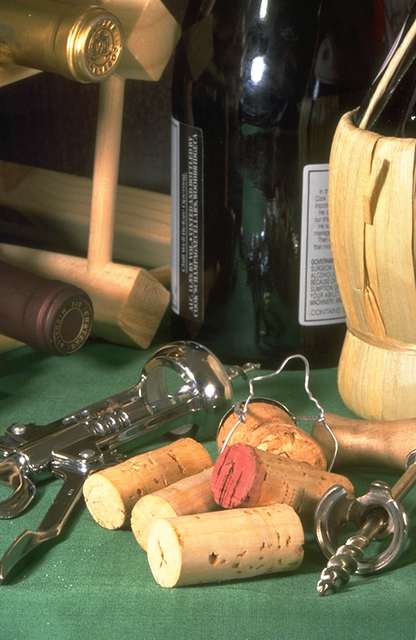 |
 |
 |
Italian Grappa Producers
(Selection)
Brunello
Marzadro
Nardini
Stock
About the Dispute
TDCA
(Trade, Development and Cooperation Agreement between the EU and South Africa)
"Assessing
the EU-SA Agreement"
Legislation
Trading
into the Future: The Introduction to the WTO
WTO Trips Agreement Text
EU Regulation 1576/89
Background Free-Backgrounds.com
Dispute Image: Hitbox
E-mail Image: Microsoft Clip
Gallery Live 2000
Flags: Animation Factory
Gavel: Hitbox
Grappa Bottle Image: Castelo
Banfi (with permission)
Maps: Art Explosion Library distributed by Nova
Development Corporation
Other Images: Art Explosion Library distributed by Nova
Development Corporation